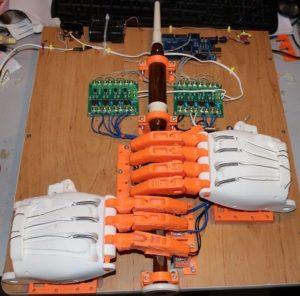Bagpipes aren’t easy to play. I have a dim memory of trying to play them myself once when I was a very young child, when a relative who plays them let me try them out. I couldn’t get them to make a sound, and quickly wrote off that career idea. But even adults with pipe dreams don’t start out playing the full instrument. When a piper begins learning how to play the bagpipes, they typically start with what’s called a practice chanter, which is a single pipe that allows the novice to learn the technique before adding in the additional complications of the bag and drones. It’s also much quieter than a full set of bagpipes, mercifully, because even the most hardcore fans of the instrument will agree that badly played pipes are an agony to listen to.
 Inventor John Dingley, aka XenonJohn, decided to automate the playing of bagpipes by creating an actual robot piper named, amusingly, Ardu McDuino. The device, at this point, is basically a giant pair of 3D printed hands that play a practice chanter, and you can make one yourself thanks to Dingley’s Instructable, if you decide that an android wailing “Scotland the Brave” is exactly what has been missing in your life.
Inventor John Dingley, aka XenonJohn, decided to automate the playing of bagpipes by creating an actual robot piper named, amusingly, Ardu McDuino. The device, at this point, is basically a giant pair of 3D printed hands that play a practice chanter, and you can make one yourself thanks to Dingley’s Instructable, if you decide that an android wailing “Scotland the Brave” is exactly what has been missing in your life.
Ardu McDuino is powered by an Arduino Mega 2560, and if its hands look familiar, it’s because Dingley used e-NABLE’s well-known Raptor Reloaded prosthetic hand design. We’ve seen this design customized and printed to give a young boy the ability to play basketball, as well as to help hundreds of others in need, but I will confidently bet that this is the first time the Raptor Reloaded – or any of e-NABLE’s designs – has been used for a bagpipe-playing robot.
“The finger tips are lifted off the holes of a bagpipe chanter with 12V DC solenoids,” Dingley explains. “The solenoids are controlled by the Arduino board via opto-isolated MOSFETS which can be bought on low cost boards fully assembled in groups of four.”
Dingley wrote a code for the robot based on piping instructions from the Teach Yourself Bagpipes website. While he admits that it may be easier to turn the chanter on its side and arrange the solenoids so that they press directly onto the holes, moving fingers just look cooler, in his opinion – and he eventually wants to add arms and a head.
Dingley provides detailed instructions in 33 steps about how to 3D print and assemble the hands – which are actually just seven fingers and a thumb, custom fit to each hole on the chanter – and the electronic components. He also includes Arduino sketches he created to have the robot play “Amazing Grace” and “Highland Cathedral” (rather badly in the latter case, he admits).
Ardu McDuino is a work in progress; Dingley states that he intends to keep improving the control software with the goal of eventually creating beautiful music. It’s a pretty inexpensive project to tinker around with, and all STL files are included in the Instructable. Check out the talents of Dingley’s robot piper below:
Discuss in the Robot Bagpipes forum at 3DPB.com.
Subscribe to Our Email Newsletter
Stay up-to-date on all the latest news from the 3D printing industry and receive information and offers from third party vendors.
Print Services
Upload your 3D Models and get them printed quickly and efficiently.
You May Also Like
U.S. Navy Lab Uses 3D Printing to Reduce Tooling Lead Time By Over 90%
The F-35 Lightning II Joint Program Office (JPO), responsible for life-cycle management of the key fifth-generation joint strike fighter (JSF) system used by the U.S., its allies, and its partners,...
Etsy Design Rule Change Reduces Selection of 3D Printed Goods
Online marketplace Etsy has implemented a rule change requiring all 3D printed goods on the site to be original designs. The update to the site’s Creativity Standards states, ¨Items produced using...
Honeywell Qualifies 6K Additive’s Nickel 718 for 3D Printed Aerospace & Defense Parts
6K Additive is renowned for manufacturing sustainable additive manufacturing (AM) powder, and offers a wide portfolio of premium metal and alloy powders that include titanium, copper, stainless steel, and nickel,...
MetalWorm Sells WAAM Systems to Research Institutes in Brazil and Malaysia
Turkish WAAM firm MetalWorm has sold a system in Malaysia and another in Brazil. This is an excellent example of a few emerging trends in additive. Firstly, WAAM was experimented...



































